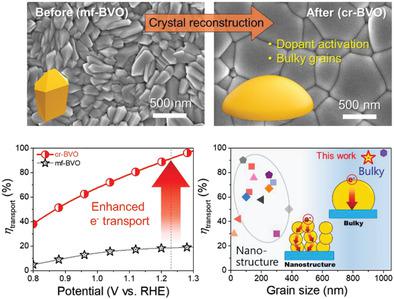当前位置:
X-MOL 学术
›
Adv. Funct. Mater.
›
论文详情
Our official English website, www.x-mol.net, welcomes your
feedback! (Note: you will need to create a separate account there.)
Crystal Reconstruction of Mo:BiVO4: Improved Charge Transport for Efficient Solar Water Splitting
Advanced Functional Materials ( IF 18.5 ) Pub Date : 2022-09-16 , DOI: 10.1002/adfm.202208196 Yoo Jae Jeong 1, 2 , Dong Hyun Seo 1, 2 , Ji hyun Baek 3 , Min Je Kang 1, 2 , Bit Na Kim 1, 2 , Sung kyu Kim 4 , Xiaolin Zheng 3 , In Sun Cho 1, 2
Advanced Functional Materials ( IF 18.5 ) Pub Date : 2022-09-16 , DOI: 10.1002/adfm.202208196 Yoo Jae Jeong 1, 2 , Dong Hyun Seo 1, 2 , Ji hyun Baek 3 , Min Je Kang 1, 2 , Bit Na Kim 1, 2 , Sung kyu Kim 4 , Xiaolin Zheng 3 , In Sun Cho 1, 2
Affiliation

|
A multifaceted Mo:BiVO4 (mf-BVO) photoanode is grown on F-doped-SnO2 substrates via achemical bath deposition, and the crystal reconstruction process of mf-BVO is found to boost the charge transport efficiency significantly for photoelectrochemical (PEC) water splitting. The mf-BVO exhibits columnar grains with an uncommon (121) texture with high-index facets such as (112), (020), (132), and (204). The texture and high-index facets facilitate rapid surface melting and grain fusion during thermal annealing, thus leading to crystal reconstructed micron-sized BVO grains (cr-BVO). The cr-BVO has a photocurrent density ≈50 times larger than that of mf-BVO. The reason is identified as the significantly improved charge transport efficiency resulting from the dopant activation (increased carrier concentration) and bulky grains (fewer defects). Additionally, the cr-BVO exhibits improved photocorrosion resistance compared to the nanoparticle-based BVO. After coating the oxygen evolution catalyst, the photocurrent density of cr-BVO is further increased to 4.4 mA cm−2 for water oxidation reaction at 1.23 V versus the reversible hydrogen electrode, maintaining a high and stable faradaic efficiency of over 88% for 24 h. These results demonstrate that crystal reconstruction is a facile and effective pathway to improve the charge transport efficiency, opening a new avenue for developing efficient photoelectrodes for PEC water splitting.
中文翻译:

Mo:BiVO4 的晶体重构:改进的电荷传输以实现高效的太阳能水分解
多面 Mo:BiVO 4 (mf-BVO) 光阳极生长在 F 掺杂的 SnO 2上通过化学浴沉积制备基板,发现 mf-BVO 的晶体重构过程可显着提高光电化学 (PEC) 水分解的电荷传输效率。mf-BVO 显示具有不常见的 (121) 结构的柱状晶粒,具有高折射率刻面,例如 (112)、(020)、(132) 和 (204)。纹理和高折射率小面促进热退火过程中的快速表面熔化和晶粒融合,从而导致晶体重构的微米级 BVO 晶粒 (cr-BVO)。cr-BVO 的光电流密度比 mf-BVO 大 ≈50 倍。原因被确定为由掺杂剂激活(增加载流子浓度)和大颗粒(更少缺陷)导致的电荷传输效率显着提高。此外,与基于纳米颗粒的 BVO 相比,cr-BVO 表现出更高的耐光腐蚀能力。涂覆析氧催化剂后,cr-BVO的光电流密度进一步增加至4.4 mA cm-2相对于可逆氢电极在 1.23 V 下进行水氧化反应,在 24 小时内保持超过 88% 的高且稳定的法拉第效率。这些结果表明,晶体重构是提高电荷传输效率的一种简便有效的途径,为开发用于 PEC 水分解的高效光电极开辟了一条新途径。
更新日期:2022-09-16
中文翻译:

Mo:BiVO4 的晶体重构:改进的电荷传输以实现高效的太阳能水分解
多面 Mo:BiVO 4 (mf-BVO) 光阳极生长在 F 掺杂的 SnO 2上通过化学浴沉积制备基板,发现 mf-BVO 的晶体重构过程可显着提高光电化学 (PEC) 水分解的电荷传输效率。mf-BVO 显示具有不常见的 (121) 结构的柱状晶粒,具有高折射率刻面,例如 (112)、(020)、(132) 和 (204)。纹理和高折射率小面促进热退火过程中的快速表面熔化和晶粒融合,从而导致晶体重构的微米级 BVO 晶粒 (cr-BVO)。cr-BVO 的光电流密度比 mf-BVO 大 ≈50 倍。原因被确定为由掺杂剂激活(增加载流子浓度)和大颗粒(更少缺陷)导致的电荷传输效率显着提高。此外,与基于纳米颗粒的 BVO 相比,cr-BVO 表现出更高的耐光腐蚀能力。涂覆析氧催化剂后,cr-BVO的光电流密度进一步增加至4.4 mA cm-2相对于可逆氢电极在 1.23 V 下进行水氧化反应,在 24 小时内保持超过 88% 的高且稳定的法拉第效率。这些结果表明,晶体重构是提高电荷传输效率的一种简便有效的途径,为开发用于 PEC 水分解的高效光电极开辟了一条新途径。































 京公网安备 11010802027423号
京公网安备 11010802027423号